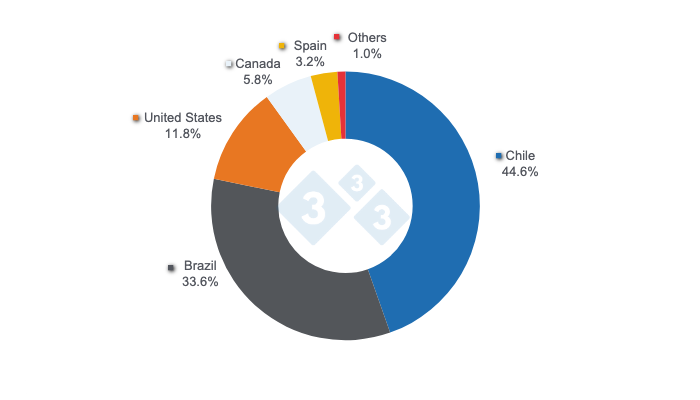
Balance of key indicators for Peruvian pig farming in 2024. Prepared by 333 Latin America with data from the Ministry of Agrarian Development and Irrigation of Peru (MIDAGRI) and the National Superintendency of Customs and Tax Administration (SUNAT).
- The total number of pigs in 2024 was 3,976,267 head, an increase of 5.3% compared to 2023.
- In 2024, the number of pigs slaughtered in slaughterhouses totaled 2,502,916 head, an increase of 3.5% compared to 2023.
- At the regional level, the largest volume of slaughter in slaughterhouses was recorded in Lima, accounting for 60% of the overall total, followed by Arequipa (14.1%), La Libertad (7.3%), Cajamarca (3.2%), and San Martin (3.1%). Together, these five regions accounted for 87.6% of the slaughter in slaughterhouses.
- Domestic pork production reached 208,538 tons (t), an increase of 4.0% compared to the previous year (200,450 t).
- Imports of pork products and by-products in 2024 totaled 17,477 t, up 7.7% from 2023.
- More than 44% of the imported product in 2024 came from Chile, while Brazil and the United States accounted for 33.6% and 11.8%, respectively. These three countries accounted for 90% of pork imports last year.
- Brazilian product, with 5,878 tons consolidated in 2024, increased in volume by 221.0 % over the previous year, while U.S. product increased by 5.6%.

Countries of origin share of total Peruvian pork products and by-products imports in 2024. Prepared by 333 Latin America with data from the National Superintendence of Customs and Tax Administration (SUNAT).

- Pork from Chile fell by 21.5%, going from 9,929 t in 2023 to 7,796 t in 2024.
- Five tariff items accounted for 85% of total imports in 2024: boneless frozen pork (39%), other frozen pork (12%), frozen chops and ribs (15%), pork fat not rendered (10%), and bone-in hams and shoulders (8%).
- Apparent pork consumption in Peru for 2024 is estimated at 226,015 t, an increase of 4.3% compared to 2023 and a per capita consumption of 10.5 kg/inhabitant/year.
- Domestic production made up 92% of the apparent consumption, and imports 8%.
333 Latin America with data from the Ministry of Agrarian Development and Irrigation of Peru (MIDAGRI) and National Superintendency of Customs and Tax Administration (SUNAT).
https://www.gob.pe/midagri
https://www.sunat.gob.pe/




